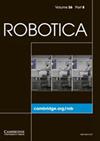与变压器的多模态交互:用自然语言架起机器人与人类的桥梁
IF 2.7
4区 计算机科学
Q3 ROBOTICS
引用次数: 0
摘要
语言引导视觉机器人抓取任务的重点是使机器人能够根据人类语言指令抓取物体。然而,现实世界的人机协作任务往往涉及语言指令不明确和场景复杂的情况。这些挑战出现在对语言查询的理解,视觉和语言信息中关键概念的区分,以及机器人末端执行器可执行抓取配置的生成。为了克服这些挑战,我们在本研究中提出了一种新的基于多模态变压器的框架,该框架可以帮助机器人使用文本查询和视觉感知来定位物体的空间交互。这个框架便于根据人类指令抓取物体。我们开发的框架由两个主要组件组成。首先,使用视觉语言转换编码器对文本中提到的对象进行多模态交互建模。其次,框架进行关节空间定位和抓取。广泛的消融研究已经在多个数据集上进行,以评估我们模型中每个组件的优势。此外,物理实验已经在物理机器人上进行了自然语言驱动的人机交互,以验证我们方法的实用性。本文章由计算机程序翻译,如有差异,请以英文原文为准。
Multi-modal interaction with transformers: bridging robots and human with natural language
Abstract The language-guided visual robotic grasping task focuses on enabling robots to grasp objects based on human language instructions. However, real-world human-robot collaboration tasks often involve situations with ambiguous language instructions and complex scenarios. These challenges arise in the understanding of linguistic queries, discrimination of key concepts in visual and language information, and generation of executable grasping configurations for the robot’s end-effector. To overcome these challenges, we propose a novel multi-modal transformer-based framework in this study, which assists robots in localizing spatial interactions of objects using text queries and visual sensing. This framework facilitates object grasping in accordance with human instructions. Our developed framework consists of two main components. First, a visual-linguistic transformer encoder is employed to model multi-modal interactions for objects referred to in the text. Second, the framework performs joint spatial localization and grasping. Extensive ablation studies have been conducted on multiple datasets to evaluate the advantages of each component in our model. Additionally, physical experiments have been performed with natural language-driven human-robot interactions on a physical robot to validate the practicality of our approach.
求助全文
通过发布文献求助,成功后即可免费获取论文全文。
去求助
来源期刊

Robotica
工程技术-机器人学
CiteScore
4.50
自引率
22.20%
发文量
181
审稿时长
9.9 months
期刊介绍:
Robotica is a forum for the multidisciplinary subject of robotics and encourages developments, applications and research in this important field of automation and robotics with regard to industry, health, education and economic and social aspects of relevance. Coverage includes activities in hostile environments, applications in the service and manufacturing industries, biological robotics, dynamics and kinematics involved in robot design and uses, on-line robots, robot task planning, rehabilitation robotics, sensory perception, software in the widest sense, particularly in respect of programming languages and links with CAD/CAM systems, telerobotics and various other areas. In addition, interest is focused on various Artificial Intelligence topics of theoretical and practical interest.
 求助内容:
求助内容: 应助结果提醒方式:
应助结果提醒方式:


